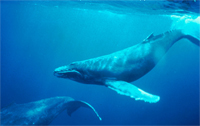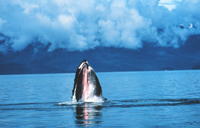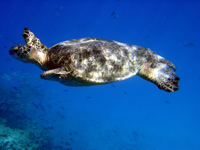Volunteers Count Whales in NOAA’s Hawaiian Islands Humpback Whale National Marine Sanctuary
February 25, 2008

Humpback whales in the singing position.
+ High Resolution (Credit: NOAA)
More than 700 volunteers gathered data from the shores of Oahu, Kauai, the Big Island, and Kahoolawe for Saturday’s annual Hawaiian Islands Humpback Whale National Marine Sanctuary Ocean Count.
Participants tallied humpback whale sightings and documented the animals’ surface behavior during the survey, which will continue on the last Saturdays in February and March. The sanctuary, which is managed by NOAA, protects humpback whales and their habitat in Hawaiian waters where they migrate each winter to mate, calve, and nurse their young.
Volunteers collected data from 57 sites statewide. The following are the average numbers of whales sighted per 15-minute count period on each of the islands:
O‘ahu – 3 whales
Kaua‘i – 6 whales
Big Island – 3 whales
Kaho‘olawe – 21 whales

Humpback whale spy-hopping.
+ High Resolution (Credit: NOAA)
Scientific studies have shown that Hawaii’s humpback whale population has been increasing at an annual rate of approximately seven percent. Over time, data from the Sanctuary Ocean Count can be used to corroborate these findings. Hawaiian waters provide critical breeding habitat for approximately two-thirds of the north Pacific stock of humpback whales.
“February is the peak of whale season in the Hawaiian Islands and it’s the best time to get outside and see humpback whales,” said Christine Brammer, Sanctuary Ocean Count coordinator. “The Ocean Count project provides a unique opportunity for the public to learn about Hawai`i’s humpbacks and the sanctuary and understand what is being done to protect the humpbacks from threats such as entanglement.”

Green sea turtle.
+ High Resolution (Credit: NOAA)
The weather around the state was perfect for viewing whales with the exception of some vog. Although counters were tasked with counting humpback whales, many other species including spinner dolphins, green sea turtles, Hawaiian monk seals, and a variety of seabirds were spotted.
One more Sanctuary Ocean Counts is scheduled to take place on Mar. 29. Previous Ocean Count results are available on the sanctuary’s Web site. For more information on becoming a Sanctuary Ocean Count volunteer, contact the appropriate sanctuary office. On the Big Island, call 1-888-55-WHALE ext. 253. On Oahu, call 397-2651 ext. 253. On Kauai, call 1-808-246-2860. A whale count on Maui is conducted independently by the Pacific Whale Foundation.
The National Oceanic and Atmospheric Administration, an agency of the U.S. Commerce Department, is dedicated to enhancing economic security and national safety through the prediction and research of weather and climate-related events and information service delivery for transportation, and by providing environmental stewardship of our nation's coastal and marine resources. Through the emerging Global Earth Observation System of Systems (GEOSS), NOAA is working with its federal partners, more than 70 countries and the European Commission to develop a global monitoring network that is as integrated as the planet it observes, predicts and protects.
